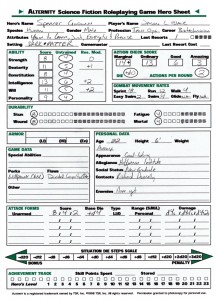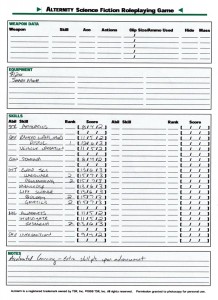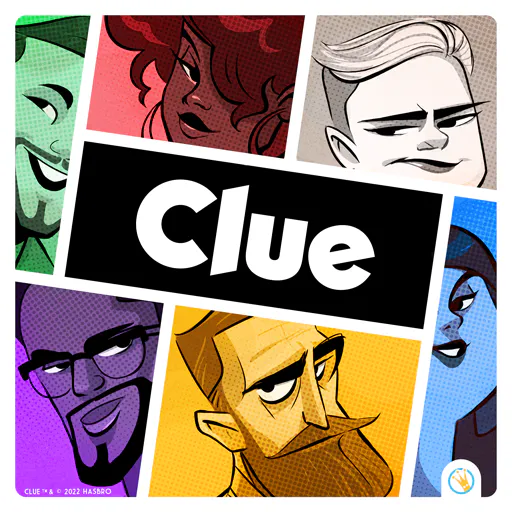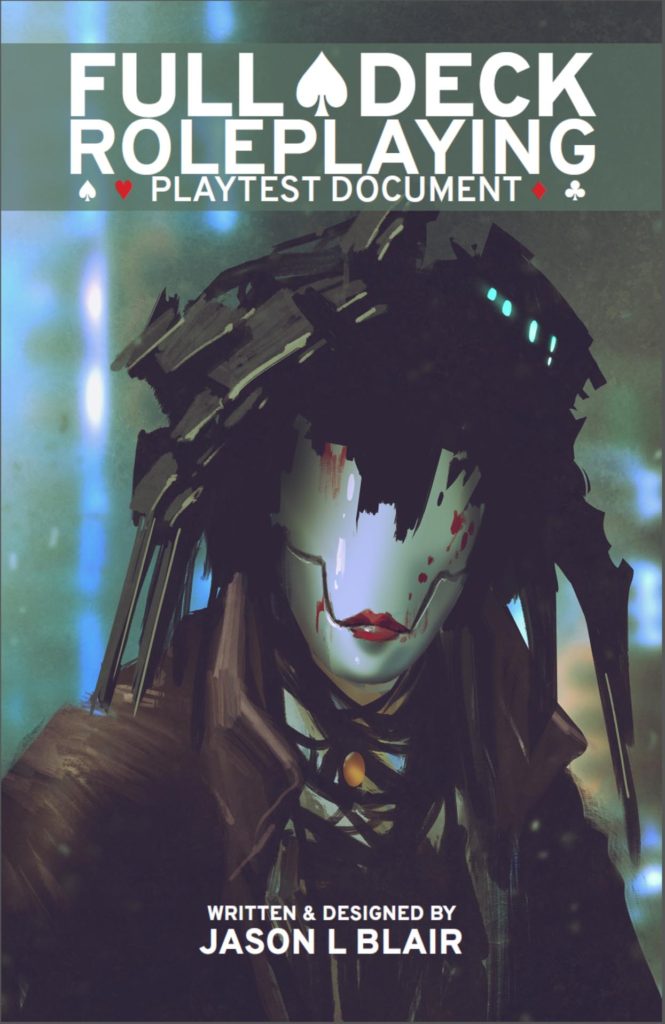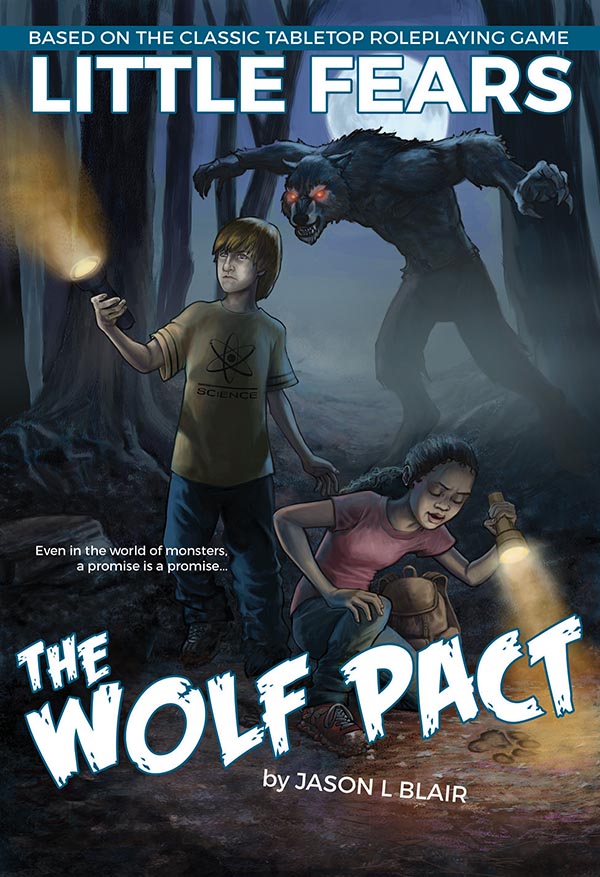I was turned onto Alternity about this time last year. Though I forget the source of the initial spark, the fire caught quick and burned bright. I read everything I could on it, scouring Wikipedia, online reviews, and the excellent fan community website AlternityRPG.net. Something about the game hooked me and, through resources such as Noble Knight, gifts from very generous friends, and the occasional rare find at used book stores, I’ve managed to collect almost everything that was released for the line.
You could say I’ve become quite the fan. Unfortunately, I haven’t had a chance yet to play it. I haven’t even made a character. But I’m going to fix that last part right now.
A Bit about Alternity
Designed by Bill Slavicsek and Richard Baker, Alternity was TSR’s sci-fi cousin to its fantasy titan Dungeons & Dragons. Two books form the basis of the system, the Player’s Handbook and the Gamemaster Guide, with supplements rounding out the core concept and a handful of campaign settings that tort the system towards various ends.
Alternity is a generic system, as much as any system can be generic, and differentiates itself from its cousin in a couple notable ways. The first is a roll-under system, which has a penalty- and bonus-focused step system where a player rolls a control die (d20) and another die (anything from d4 to 3d20) and either adds or subtracts that second die from the control die based on situational modifiers and whatnot. The second notable is an experience system based on achievements, wherein characters get access to bigger and better things (such as leveling up skills and abilities) by completing certain goals throughout a game session. It’s a subtle touch, but given its place in history, a much-needed one. Oh, and a third is its initiative system, called Action Check, which has this cool four-phase system for determining who acts when. I won’t get into it too much here but more information can be found online. I really like that set-up for actions.
The Alternity game line lived for just over two years. During its development prior to release, its parent TSR was bought out by Wizards of the Coast, and then, in 2000, Dungeons & Dragons 3rd Edition introduced d20 and its open gaming license and changed the face of popular gaming. Though the Alternity system was a casualty of that shift, parts of it did live to see the light of day yet again.
Campaign Settings
Four official campaign settings were released: two original, one classic, and one licensed.
The first original setting, Star*Drive, took the Alternity to its logical space opera extension. Star*Drive concerned itself with life in the Verge and had all the juicy space opera bits you could want: exotic locales, strange alien races, fragile alliances, and far-reaching political machinations. This was the most supported of all the Alternity lines.
The second original setting, Dark•Matter, took Alternity to a rather unexpected place: modern conspiracy horror. Four books were released for this setting but they’re good stuff: the main campaign setting, a weapons and equipment guide, a lengthy scenario, and a brilliant monster book called Xenoforms.
The third setting was the revival of the venerable post-apocalyptic stage, Gamma World. This was the setting’s fifth incarnation and also its shortest as it only saw one book, the core book, released.
The fourth and final setting was StarCraft, based on Blizzard Entertainment’s wildly popular eponymous real-time strategy game for the PC. Released as a box set, the product included a couple booklets and some dice, everything you needed to play the game. It used a streamlined (for some, stripped down) version of the Alternity rules.
The two signature Alternity settings were brought back under d20 Modern and d20 Future respectively.
Let’s Make a Character
For the character collection today, I’ve chosen my favorite of the official campaign settings, Dark•Matter. In Dark•Matter, you are an agent of the Hoffmann Institute, a shadowy global conspiracy that studies the true history of the world, collects and catalogs bizarre finds, and protects all us regular folk from things that bump and snarl and drive mortals beyond the brink of madness.
It’s like Wolfgang Baur and Monte Cook, the authors of the core book, read my mind and wrote a game specifically to draw me in. (And, given the concept, maybe they did. *cue theremin music*)
Game: Dark•Matter
Publisher: Wizards of the Coast
System: Alternity
Books Needed: Alternity Player’s Handbook, Dark•Matter Campaign Setting Core Book
Note: Character creation rules are contained within the Alternity Player’s Handbook with additional skills, perks, and flaws presented in the Dark•Matter main book. According to page 20 in the aforementioned Player’s Handbook, you can create a character in nine steps. Also, though Dark•Matter includes its own version of the character sheet, I’m using a generic Alternity sheet as that’s what I can print from PDF.
Let’s begin!
Click “Read More” to jump down the rabbit hole.
Step 1: Develop a Hero Concept
The most obvious inspiration for a Dark•Matter character is Fox “Spooky” Mulder from The X-Files, Olivia Dunham from Fringe, Agent Lattimer and Bering from Warehouse 13, or maybe even a human agent from the BPRD but I think I want to go a little different. In 2010, wrangling the world of the bizarre is going to take more than a quick draw, a snappy comeback, and a strong stomach.
The Hoffmann Institute is a well-oiled and very large machine, with offices and divisions spread throughout the globe. It has interests and experts in a variety of fields. It also, as it just so happens, has a branch of the Archives Division is a city fairly local to me. My guy is a biotechnician for the Chicago Specimen Collection. He does all the fancy examinations and whatnot like you see on Bones. He holds two doctorates, one in Biology from CUNY and another in Computer and Information Sciences from DePaul.
He dreamed of working at the Smithsonian or getting in at a large biotech firm but that was cast aside after an eventful backpacking trip. He and some buddies decided to blow off some steam after graduation by hiking through the Pacific Northwest. During the third day, while filling their water bottles at a stream, they were attacked by some strange winged beasts. One of Spencer’s friends was killed (oh hey, I just named him) and another taken off by one of the featherless bird-things. Spencer phoned for the police, described the improbable situation as best as his frazzled and terrified brain could, before finding a nice dark cave in which to hide.
Though he had phoned 911, it wasn’t the police who came. It was a group of men and women in black suits, led by a gent in civilian clothes. He was the one who spoke with Spencer, got all the details and saw that the boy was airlifted to safety, away from the scene.
Spencer wasn’t taken to a hospital (he wasn’t injured beyond shallow scrapes) or back home. Instead, he was taken an unmarked building where he was debriefed and held, in relative comfort, for three days. On the fourth day, after a full background check and psychological evaluation, he was released with strict orders not to say anything to anyone.
Life went by pretty normal for Spencer. He mourned his dead friend and learned that his missing buddy had been retrieved and was currently admitted to Providence Portland Medical Center. He dealt with things as best he could but the experience nagged at him. He couldn’t sleep, was becoming despondent. He obsessed over the bird creatures, refusing to accept the official explanation of “migratory condors” and he spent all hours researching. It was when he went to visit his friend at Providence Portland that he met the man in the civilian clothes again. Spencer unleashed a thousand questions at the man, demanding a more satisfying answer.
“You want a better answer?” The man replied. “Then help us find one.”
The man gave Spencer a card with a phone number on it. The next morning, Spencer called and the rest is history.
I put on the sheet my character’s name: Spencer Godwin.
Alright, let’s get to the meat.
Step 2: Choose a Species
Human. Done.
Step 3: Choose a Career
He’s a biotechnician for the Hoffmann Institute.
Step 4: Pick a Profession
Unlike career above, professions are standardized across four types: Combat Spec, Diplomat, Free Agent, and Tech Op. Each covers a variety of specializations and jobs and each gives system bonuses called “special benefits.”
Spencer is a Tech Op. He gains an Action Check Score Increase (Action Checks are like Initiative and determine who can act when) and Accelerated Learning which means I get extra skill points every level. Pretty nice!
I’ll add the Action Check bonus when I calculate that but I’ll make the other benefit a note so I remember it come leveling time.
Step 5: Assign Ability Scores
Abilities are the core of a character, mechanically-speaking. There are six Abilities and they might look familiar to a lot of you. Alternity heroes are built with points. I have 60 points to divide among the Abilities. Human Abilities range from 4 to 14, higher being better. Also, each Profession has minimum Ability requirements I must be mindful of.
As a Tech Op, I need a Dexterity of 9 or better and an Intelligence of 11 or higher. I’ll focus on those first. Spencer is really smart, say Intelligence of 13, so I put that down. His Dexterity is good, say 11. That’s 24 points spent giving me 36 left and four Abilities to fill. That’s an average of 9 per Ability. Let’s lower Strength and Constitution a bit and increase Will (remember his dogged research and focus). In the end, Spencer breaks down like this:
Strength: 8
Dexterity: 11
Constitution: 8
Intelligence: 13
Will: 11
Personality: 9
Okay, let’s run the math: 8+11 (19) + 8 + 13 (21) (21+19 = 40) + 11 + 9 (20). Yep, 60 points.
Step 5a: Determine Options
Hey, what’s this 5a business? Oh, these are for characters who are mutants or have integrated cybertechnology. My character has neither (but I have in mind many settings where one or both are possible!) so the only thing for me to do in this step is determine my “Untrained” score and Resistance Modifier.
My “Untrained” score, which I’ll use when I attempt to use a skill I don’t have and have to rely on its related Ability, is half the related Ability’s score, rounded down.
Resistance Modifiers are either bonuses or penalties to an action taken by another character toward my character. This is my character’s natural, passive resistance to an action. I consult a table for this and get my numbers. (Constitution and Personality lack modifiers; they are only used actively).
Step 6: Purchase Skills
This is where the practicality of my character will come into play. I already know I don’t want Spencer to be a desk jockey. Sure, he spends a lot of time behind the microscope and mass spectrometer but I need him to be able in the field as well. He’ll likely be paired with folks who spend time on the hunt and if he’s useless he’s a liability.
Skills in Alternity are done like this: There are Broad Skills and Specialty Skills. Broad Skills are the big categories (Athletics, Computer Science, Ranged Weapons) with Specialty Skills fitting under those categories (so, the same order as above, Climb, Hacking, Rifle are specialties). You must have the Broad Skill in order to buy any of the Specialty Skills.
Every character gets six Broad Skills for free, based on Species.
Skills are bought the same as Abilities. The number of points allowed is determined by the character’s Intelligence. Since humans are the base species of the realm and don’t get any innate perks, they get five extra Skill Points and an extra Broad Skill.
In Spencer’s case, all told, he gets 55 Skill Points and can buy up to 6 Broad Skills, not counting the 6 free ones. The cost structure is interesting in that you get a discount on Skills related to your Profession and also in that you buy Skills in steps, paying X for Rank 1, Y for 2, Z for 3. I don’t grok the rules as written without reading the example, which doesn’t quite seem to mesh with the text, but I’ll go with the example as it makes the most sense to me.
The selection process is a bit involved, especially fiddling the costs for everything, so I’ll gloss over the specifics of why I chose what and how and just give you the list.
(Note: For this, there are new Skills present in the Dark•Matter core book so, for those of you following along at home, you won’t find all of these in the Player’s Handbook.)
Here’s what I choose.
(Broad Skill
– Specialty Skill)
Athletics
Ranged Weapons, Modern
– Pistol
Vehicle Operation
Stamina
Computer Science
– Hardware
– Programming
Knowledge
Life Science
– Biology
– Genetics
Awareness
Investigate
– Research
Interaction
Alright, not bad. I didn’t get everything I would have liked but that’s okay. That gives this character some aspiration.
Now I just need to calculate my scores for each Skill. And not just one score per Skill, no, but three scores (which, in play, determine just how awesome my success was).
The Skill process isn’t particularly difficult but it is a bit of a time sink.
Step 7: Select Perks & Flaws
Those of you familiar with RPGs in the 90s have probably been waiting for some sort of advantage/disadvantage system to pop up. Well, here it is.
Perks are innate abilities or qualities that help your character; flaws are similar but work against your character. You can buy Perks with Skill Points or you can earn Skill Points by taking Flaws.
No good character is perfect. Let’s give Spencer some Flaws.
When imagining Spencer, I didn’t have any particular Flaws in mind but that’s okay. As I read through the listings in both the Player’s Handbook and Dark•Matter core book, I start to think that broadening Spencer’s character is a really good idea.
I wonder: What if Spencer is beholden to somebody? Maybe he comes from a poor background and he wasn’t able to pay for all his schooling on his own. Maybe someone saw potential in him and paid his way. And what if that person has interests contrary to the Hoffmann Institute. Yeah, I like that.
The man’s name is Richard Donnelly and he’s a friend of Spencer’s deceased father. Uncle Rich has been in Spencer’s life since the childhood and Spencer trusts the older man without hesitation.
I take the Flaw “Divided Loyalty” which covers this. It gives four additional Skill Points, which is nice, but more importantly it gives my character something meaty to contribute to the story.
I’m going to flip those four points right around and pick up the Perk “Willpower.” This gives Spencer a +1 to his Will’s Resistance Modifier, making it a +2. Spencer’s a willful guy who isn’t deterred easily.
Step 8: Choose Attributes
There are three Attributes: Motivation (the character’s “purpose”), Moral Attitude (his personal values), and Character Traits (which round out a character’s personality).
Some Motivations are listed in the Player’s Handbook. Interesting ones include “Loose End” (something is unresolved in the character’s past), “On a Mission” (driven by a goal), and “Deeper Meaning” (the hero is compelled to understand his place and the world around it).
I like “Yearn to Learn” which is a drive is “knowledge for its own sake.”
His Moral Attitude is “Just.” There are a lot to choose from. I don’t choose “Apathetic” or “Conformist,” as those run counter to his being a willful character, or “Selfish” or “Unscrupulous” because I don’t see him being a jerk. The rest just don’t fit.
For Character Traits, there’s a big old list. I can choose up to two of them. I like “Energetic” and “Precise.” He does things quickly but correctly. And he probably expects the same from others.
Step 9: Complete the Hero Sheet
Alright, we’re almost done. Just a few fiddly bits and blank spaces to fill in. Let’s get to it.
The standouts are Last Resorts (points used to get a character out of a bad situation—maybe), Action Check (which determines how fast I act and how many times I act in a round), Durability (how much of what type of damage Spencer can take before he goes down), Personal Data (see the sheet), and then weapons and equipment.
And, heh, for the first time this session, I’m breaking out dice. 5d8 to be exact. These are to determine Spencer’s starting cash. Hold on while I get dice.
I rolled 3, 3, 4, 5, 7 for a total of 22. Multiply that by 10, the rules say, so I have $220.
As he works for the Hoffmann Institute, I imagine they’ll equip him with essentials when on the field so I leave pistol, armor, etc. to be defined later. I do want him to have a cell phone though. The books says that costs $100, which isn’t far off the mark. So, Spencer has a smartphone for personal use with an unlimited data plan. It’s his number one means of keeping in touch with friends and family. The rest of his time is spent working the Chicago Specimen Collection.
And that’s it! Spencer Godwin, hero-in-waiting, is ready to play.
In Sum
Alternity is a fun system and I really look forward to seeing it in action. Though the system is a bit fiddly, I was able to wrap my head around it and I think it will flow after a session or two. What I really love is the Dark•Matter setting (and Star*Drive isn’t shabby either). If any locals have interest in a Dark•Matter campaign, just let me know. It may be an oldie but there’s a lot of goodie to be had.

